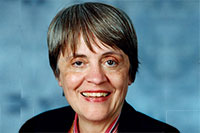
Students (front, from left) Margaret McWhorter, Tanvi Sheth, Kalli Kling and Matthew Kaufmann prepared the federal civil rights case representing Michael Knuth. They were joined by (in back) Katie Anderson, Pro Bono Program coordinator and staff attorney, and Professor F. Willis Caruso, Pro Bono Program director.
A judge’s request for students at The John Marshall Law School to handle a federal civil rights case proved to be an extraordinary experience that offered them an inside look into an attorney’s role at trial.
The team was successful in obtaining a settlement in a case filed by a man who complained police used excessive force when they shot him nine times.
“Our students clearly demonstrated they can prepare a case and present it in court,” said Professor F. Willis Caruso, director of the law school’s Pro Bono Clinic. “There are many new attorneys who won’t get to handle a case like this until they’ve been at a firm for two or three years.”
Over six months, third-year students Tanvi Sheth, Samantha Sims and Kalli Kling, and second-year students Margaret McWhorter and Matthew Kaufmann prepared to represent Michael Knuth, who alleged that police used excessive force when they shot him after a traffic stop in Lincoln, Ill. Knuth was wanted on a stolen gun charge and police say in 2009, he pointed a gun at them during the traffic stop. Students were prepared to argue that police radio calls announced that Knuth “was down” after he’d been shot five times, yet a police officer and the police chief shot him four more times.
The Pro Bono Clinic took the case at the request of Chief Judge James E. Shadid of the U.S. District Court, Central District of Illinois, with students working under the supervision of Caruso and Pro Bono Program coordinator and staff attorney Katie Anderson.
“Our students handled every aspect of this case. They pored through documents, they researched issues, they strategized how they would present the facts, they went to Stateville Correctional Center to visit their client, they prepared witnesses and they video-conferenced with the other attorneys and the judge,” explained Caruso.
Sheth used her 711 license to serve as the lead attorney. She worked to develop the arguments, conduct the conferences between the opposing counsel and the judge, selected the jury and readied the opening statement. She also worked with Caruso to negotiate a settlement on behalf of Knuth.
“This was my first time in court and I was very nervous, but at the same time I knew I was prepared. We had been working for months, and my time day-in and day-out was focused on this case,” Sheth said. “We were trained that you don’t come (to court) empty handed, which is why we did so much research in preparation. We looked at this case from many angles.”
On the trial date – April 14, 2014 – the students and professors appeared before Judge Tom Schanzle-Haskins in U.S. District Court in Springfield, Ill. The team helped select a jury, put several motions before the judge and were ready for opening arguments when Knuth decided to accept an offer to settle the claim.
The students said their work gave them insights into the legal system that they wouldn’t have gotten until they were practicing attorneys.
“Yes, being in the courtroom was nerve racking,” said McWhorter, “but I had such a great feeling being there,” working on behalf of someone who needed representation. “I felt I was a part of something special, and that I was carrying on the legacy of the law.”
For Kling – who recently graduated in May – the case perfectly capped off her law school career, saying it was “the practical experience that brought it all together.”

